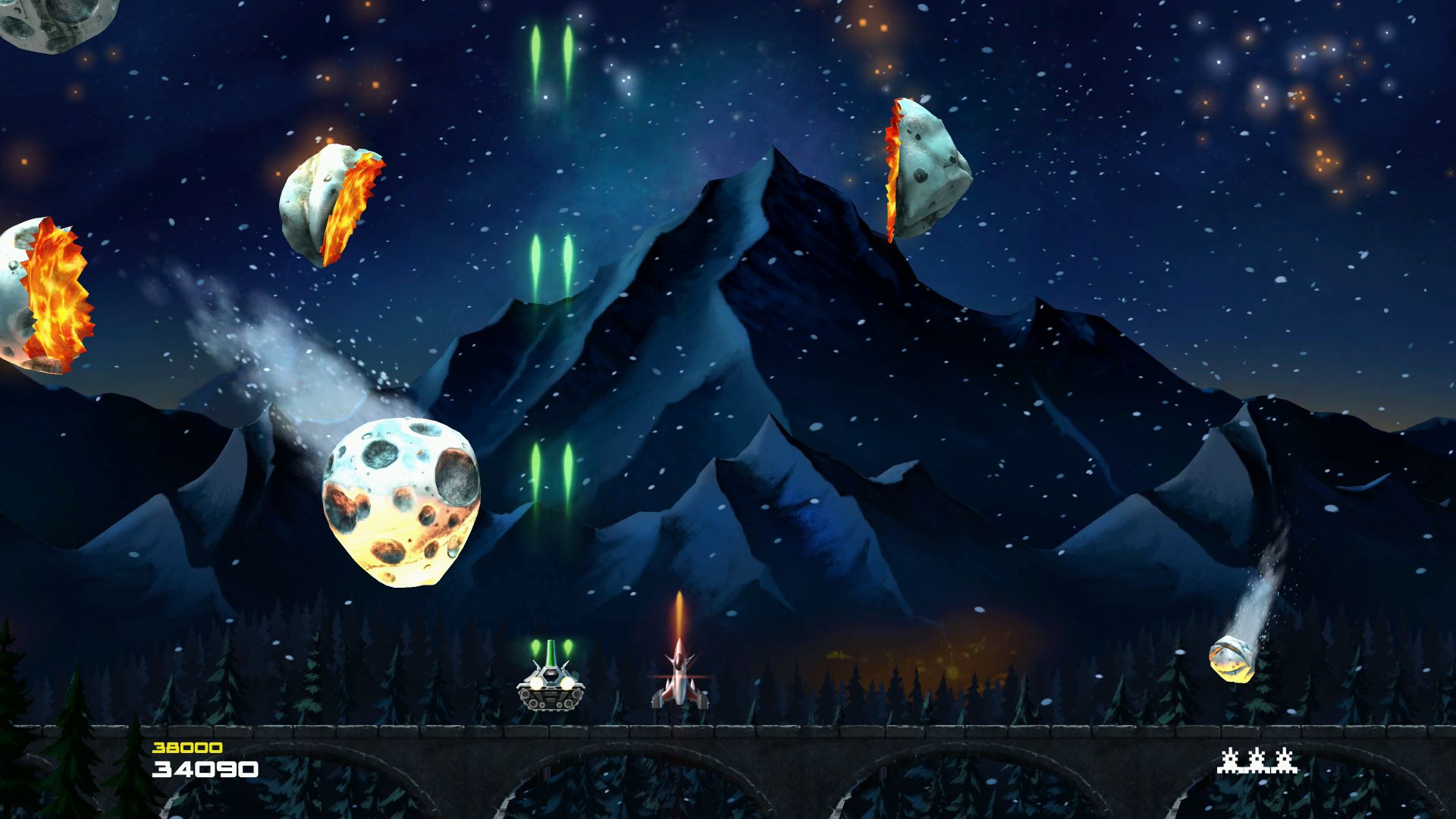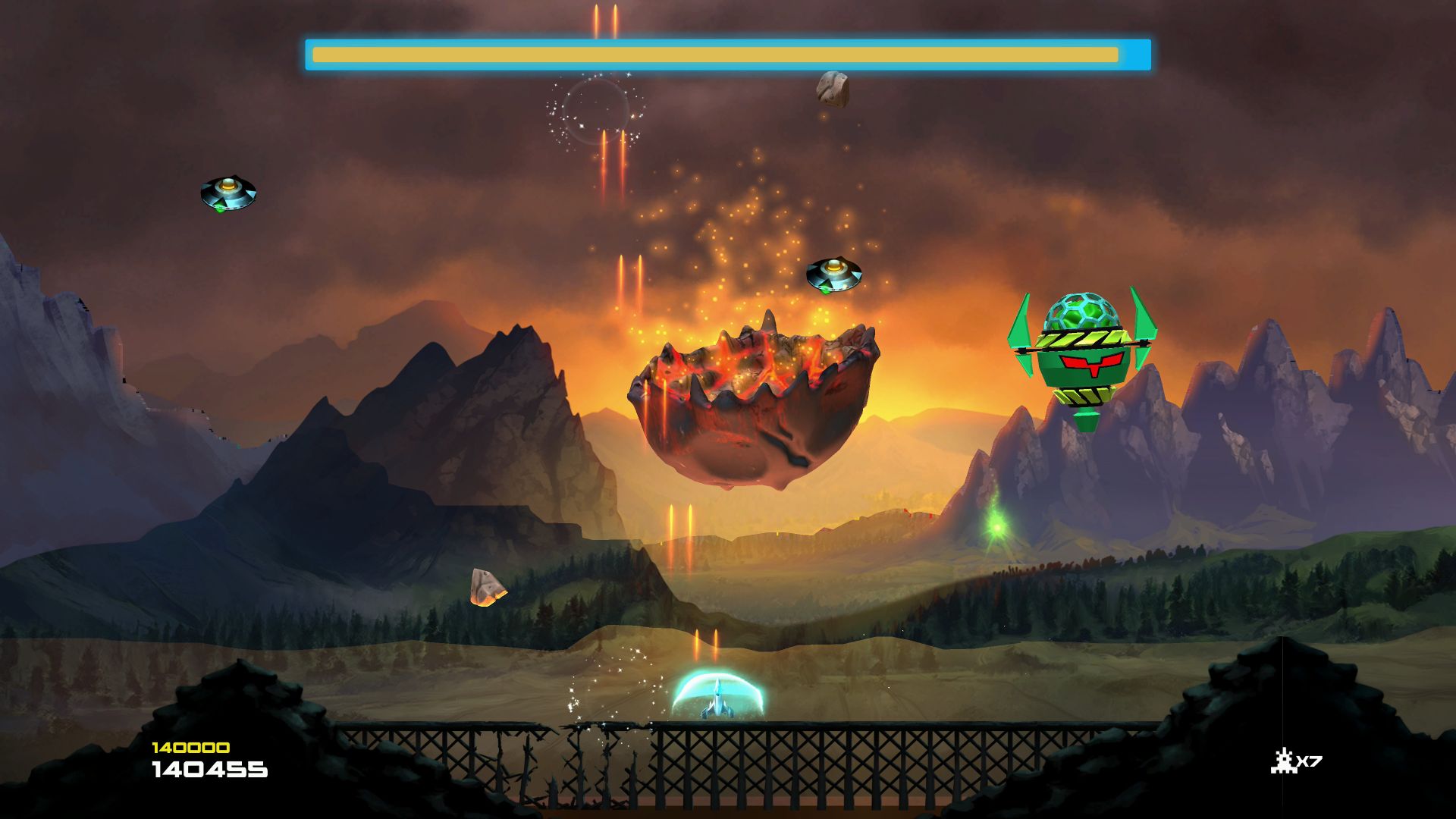In the early 1980s, it was not uncommon to find console games that were heavily inspired by arcade games of the time. One such game was 1981's Astrosmash for the Intellivision console. It combined gameplay elements from Space Invaders and Asteroids, and was apparently well-liked by Intellivision players. This year, BBG Entertainment, makers of Dynablaster, unleashed its own Astrosmash remake onto consoles and PC. The remake isn’t very ambitious, but it does seem to faithfully capture the gameplay of the original.
Astrosmash offers three modes: Campaign, Versus, and Multiplayer. Campaign and Multiplayer both support 4-player local co-op, and Multiplayer also supports online co-op.
Campaign

The campaign consists of ten levels that last about four minutes each (though they feel much longer). Players can move left and right, fire, and use a speed boost (dash) that grants brief invincibility. During each level, meteors continually fall from the top of the screen. Shooting larger meteors will split them into smaller ones, Asteroids-style. A few different types of UFO foes appear in certain levels as well. If a meteor or enemy hits a player, the team loses a life because lives are shared. Should the meteor/enemy hit the ground instead, the team’s score decreases slightly, which is no big deal.
Much of Astrosmash’s challenge comes from the limitations of the primary weapon. The default gun fires quite slowly, just as ships typically did in early 1980s shoot ‘em ups. Thankfully, power-ups can even the odds. They fall from the sky fairly regularly and offer brief advantages upon collection. Double Shot fires much more rapidly than the standard pea shooter, Plasma fires a continuous beam, Shield provides invincibility for a time, Nuke clears the screen of threats, and you can find extra lives as well. Prioritizing the collection of power-ups will greatly improve the team’s chances of survival.

Certain levels culminate in a boss battle. At first, our pilots will blast away at a gigantic meteor. Once the meteor falls, a giant UFO usually follows. These boss fights offer rare moments of excitement in the game’s otherwise overly long levels. Each level just goes on and on, and the game doesn’t provide any indication of the time remaining until the stage suddenly ends. Levels should probably be half as long as they currently are, even if it would make for a much shorter campaign.
Beating all ten levels of the campaign does play a short ending, something the original game probably lacked. The game then loops and becomes harder. There are no continues, so you'll have to play carefully in order to avoid running out of lives before that tenth level.
Versus and Multiplayer

Outside of the campaign, Versus and Multiplayer modes offer a bit more replay potential. Both modes support both local and online multiplayer, though the online component isn’t well-communicated to players. Basically, the game seems to automatically match you up with another player if they happen to be starting that mode at the same time. Unfortunately, there’s no invite or public lobby system, so you’ll basically never end up playing online with anyone else. Local multiplayer works fine, though.
Game length can be adjusted for Versus matches, but co-op Multiplayer matches run for three minutes. Players have unlimited lives, so they can play until the timer runs out.
Production Values and Missing Pauses

Astrosmash won’t exactly push the hardware on modern consoles, but its visuals offer a faithful update of the original’s style. The backgrounds, in particular, display a pleasant level of detail, and some even have animations like moving clouds and falling rain. The music is probably Astrosmash’s most impressive feature. It consists entirely of dramatic, movie-style orchestrations. The songs seem to be licensed stock music, but they’re still great tracks.
This is more of a baffling design decision than a production value issue, but Astrosmash doesn’t let players pause the game – not in any mode. Pausing is a completely standard feature found in almost every game ever made. Sure, MMOs and other online-only games sometimes don’t allow for pausing, but why wouldn’t a simple arcade-style game allow it? If you pick the wrong mode or just need to go to the bathroom, there’s nothing you can do but either let the game progress until your lives run out or just close the game at the system level and then restart it. The lack of pausing is consumer-unfriendly and makes no design sense at all.
Reviving a Classic

Another problem that Astrosmash faces is that of limited nostalgia. Specifically, the only people who remember this property are going to be those who played the original Intellivision game in the 1980s. The original is not available on modern platforms either as part of a collection or on its own. Thus, you can’t even go back to check it out via legal methods. It would’ve been easy to include the tiny Intellivision ROM within the remake, but that didn't happen.
Whether a gamer has played the original Astrosmash or not (I’ve only watched videos), it’s possible to enjoy the remake’s old-school style anyway. The core shoot ‘em up gameplay is faithful to the original and decently fun, especially in local co-op. BBG just needs to add the ability to pause and reduce the length of the campaign levels by 33-50 percent. Then you’d have an enjoyable, retro-style game that doesn’t overstay its welcome.
Astrosmash sells for $14.99 on Xbox, Switch, and Steam. The Steam version is fully Steam Deck compatible.
Xbox and Steam codes were provided by the publisher for this review.
Verdict
Co-Op Score
Overall
The Co-Op Experience: Up to four players can co-operate together to get an even higher score than in single player.
Co-Optimus game reviews focus on the cooperative experience of a game, our final score graphic represents this experience along with an average score for the game overall. For an explanation of our scores please check our Review Score Explanation Guide.
